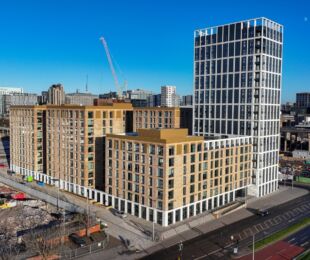
St Michael and All Angels, in north Oxford, is a curiosity: a lofty, light-filled Victorian Gothic church that is abruptly truncated by a blank brick wall that was left when funds ran out. Designed by local architect Alfred Mardon Mowbray (1849-1915), the nave and north and south aisles were left as a single bay in 1909, with a ‘temporary’ west wall. The new front extension, designed by Adrian James Architects, provides a new threshold for the church. The addition comprises a spacious entrance lobby, together with ancillary spaces that every assembly building needs like a kitchen, toilets, stores and an office. It is a tall space with a large toplight and circular timber crown in the ceiling, lending a character similar to a narthex – the intention is for the building to mediate between the secular and the sacred.
“But how to build on the front of a glorious if eccentric church?”, questioned Adrian James. Rather than hiding the historical anomaly of the brick west wall, the extension is designed “as if the church interior has oozed out of the entrance doors and set hard as a brick lozenge around an expansive glazed entrance screen addressing the public footpath through the churchyard”. The new building is intended to be both sheltering and welcoming, “which opens the church to the world and sets up a progressive sequence of increasingly special spaces from path to porch to narthex to nave”.
The plan of the brick building is a complex curved shape comprising five different radii. A Flemish bond was adopted to give the appearance of wrapping smoothly around the tightest two-metre radius, and the brickwork was carefully set out to avoid cut bricks. In addition, the recessed soldier courses, which span below and above the window openings, also required careful coordination. The main entrance uses a swept steel channel with concealed steel supports to the soldiers across the entrance. Two circular steel columns, clad with curved radial specials, break the span. The smaller window openings use curved precast concrete lintels faced with brick slips. Deep brick reveals give the pure form a really solid feel.
In terms of the brick specification, the architects wanted “a handmade brick with a high degree of precision and light variation in texture and colour; the intention was to complement the mixed hues of the existing church stone, brick and tile”. A number of test panels were erected on site before the Stamford Buff was chosen.
Hydraulic lime mortar was used and no movement joints, with deep recessed pointing to the Flemish bond brickwork and subtler recesses to the soldier courses. “The design set a high bar”, says James, “and the contractor and bricklayer have really delivered, working closely with us to ensure that complexities were resolved without contrivance to create something where it all naturally flows”. Adding to the front of a listed and loved church required careful scrutiny by multiple bodies, both statutory and corporeal, but the building has been welcomed by English Heritage, the planners, the diocese, parish and the locals, says the architect.






